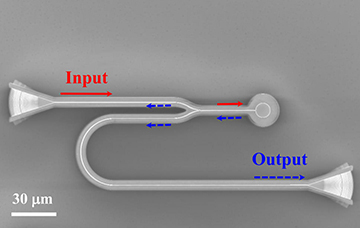
A 5-µm microdisk with a connected waveguide is coupled to a Y-splitter. This setup allows light to pass into the microdisk via the waveguide, and then transmits out along the same waveguide so that the microdisk’s light-amplification ability can be measured. [Image: Q. Song / Harbin Institute of Technology in China]
A team of researchers from China reports a counterintuitive yet efficient way of getting light into a microdisk resonator. Using a technique called end-fire light injection, they can trigger laser time reversal, which creates a laser that absorbs light instead of emitting it.
The laser time-reversal phenomenon allows light to more efficiently enter a silicon waveguide-connected microdisk (WCM) that the researchers specifically designed for this application (Optica, doi:10.1364/OPTICA.5.000612). Once in the WCM, the light signal is amplified via the whispering-gallery optical effect. The team reports demonstrating that its technique was capable of coupling light into the WCM with 57-percent efficiency, on par with conventional microdisk performance.
Being able to efficiently amplify light in the WCM means that a light signal emitted by, for example, a fluorescently tagged cell or protein of interest is easier to detect even when the signal is very weak. The researchers ultimately hope their end-fire injection technique and WCM design could make microdisk sensors more practical, cost-effective and reliable for the early detection of deadly diseases, like cancer, or for other applications, like photonic circuits for communications and environmental monitoring.
A counterintuitive light-delivery technique
Microdisks are resonators that use the whispering-gallery effect to trap and amplify light. Microdisks have shown promise for improving on-chip sensor performance, but conventional designs use evanescent light coupling and waveguide–resonator coupling configurations that require high-tech and high-cost fabrication methods.
Harbin Institute of Technology’s Qinghai Song and his colleagues say that they have found a way to make microdisk resonators more practical by using an end-fire injection light-delivery technique with a new and forgiving (fabrication-wise) WCM design. The combination of the two methods, they say, could be a better route to realizing on-chip optical sensors.
The “counterintuitive” part of the team’s light-delivery technique comes from the laser time-reversal phenomenon. Laser time reversal is induced by introducing light into the WCM at an angle less than perpendicular to the waveguide—this creates a laser that, counterintuitively, absorbs rather than emits light, which allows it to more efficiently enter the WCM for amplification.
Demonstrating light amplification and signal detection
To measure the efficiency of their end-fire light injection/WCM method, the researchers attached a Y-splitter to the WCM. Using this configuration, they were able to direct light into the microdisk, and then measure the light as it was transmitted out. The team found that light could be coupled into the WCM with an efficiency up to 57 percent and with a Q factor (how well the WCM confines amplified light) of 2×105 to 7×105, which matches conventional microdisk performance. The researchers were also able to experimentally verify that their method can be used in optical sensors to detect very small changes in temperature, as well as single and multiple light-tagged nanoparticles.
In a press release, Song says that the team has shown that the technique is not only comparable in performance to traditional microdisk designs, but also shows “improved robustness and reduced cost” and that microdisks are “now ready for commercial applications.”
